According to many, it is not quite easy to maintain a succulents In Extreme Weather. However, they are pretty easy to maintain if you follow the right methods.
If you focus on the variety of the succulent and the appropriate weather they require you will be able to feel the pure happiness of having this extremely gorgeous plant.
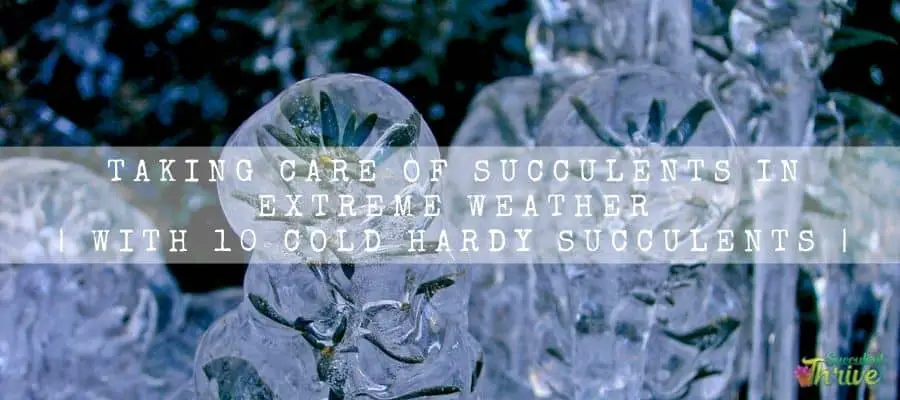
How cold can succulents tolerate?
The resilience of the succulents during cold weather depends on the type of the succulent plant. There are two types of succulents: hardy and tender succulents.
Most of what we carry are soft or tender succulents. These are spoiled or rotten by warm temperature.
They built their entire anatomy to survive warm and dry environments, leaving them completely vulnerable to freezing temperatures causing the destruction of the plant.
The minimum temperature level a succulent can withstand depends on whether it is a soft succulent or a hardy one.
Usually, soft succulents grow healthy over 32 degrees Fahrenheit. They prefer a temperature of 40 degrees Fahrenheit and above.
The freezing temperature is too frigid for succulents to survive. The plumpy and fleshy leaves where they store water begin to frost at freezing temperature. Hardy succulents resist -20 degrees Fahrenheit.
USDA hardiness zone 4 – 5 zone is considered the best to grow succulents.
Even though succulents can resist temperatures below freezing make sure the soil is dry as these plants always prefer dry soil.
Be cautious about your succulents especially when the winter gets snowy and wet. Always remember wet soil causes rotten roots.
Optimum temperature ranges for succulent
It is difficult to decide an exact temperature that is healthy for succulent plants. However, the temperatures 60°- 80°F are known to be the succulent’s friendly temperature ranges.
Some cold-hardy succulents can resist the low temperatures such as 40°F and high temperatures like 90°F.
There are succulents that change their color to extreme temperatures. Thus, many succulent lovers expose their plants to extreme temperatures to get vibrant colors.
In this process, the tone of the colours begins to intensify as the temperatures go up (Above 40°F).
It is important to know that the temperature should not be lower than 40°F or higher than 90°F as it does more damage to succulent plants.
High temperatures and direct exposure to the sun result in sunburns on succulent plants. Moreover, it damages leaves and roots.
If you are living in an area that usually has heated weather it is wise to plant your succulents on the ground without planting them on pots because the condition of the soil remains relatively perpetual despite transitions of weather.
If you prefer to plant your succulents in containers, always make sure to go for a material such as concrete, ceramic terracotta and wood that protect plants in opposition to abrupt temperature instabilities. Do not plant your succulents on metal and glass containers.
Be vigilant in maintaining the temperature above the freezing point to prevent your succulents from frost damage.
For this move the succulents into a shady area. Cold hardy succulents such as Sempervivum can survive in the frost as this species of succulents grows healthy in chilly weather from 30° to 40°F.
Tropical succulent varieties like Euphorbia and Lithops favor weather with 50°- 60°F temperature.
Hardiness information on succulent plants will guide you to identify the propriety of growing succulents for the weather in your area.
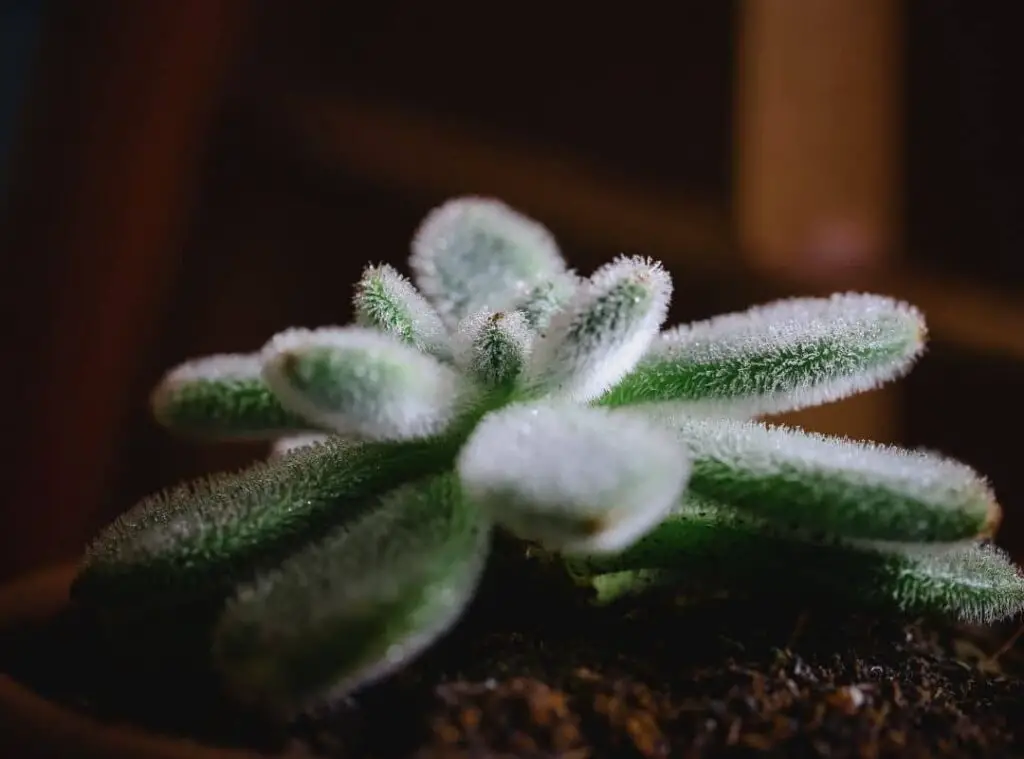
Temperature range for different succulent varieties
There are various species of succulents with different temperature tolerances
. In order to get beautiful succulents with vibrant colours, it is quite important to stabilize the environment-specific temperature exposure strategies.
When considering the temperature, it is quite necessary to place your succulent plants in an optimal hit location.
You should pay attention to the condition of the succulents and alter the environment as it is required.
Usually, succulent plants flourish under temperatures from 40°-80°F. A slight effect in temperature out of this range is durable.
However, it damages succulents at a temperature of 90° or more. It is a quite riveting fact that when temperatures drift close to the ends of the bearable spectrum around 40°F or 90°F grow stronger impacting the plants perfectly and resulting in many vigorous colors.
When it comes to winter, it is recommended to keep succulents above the freezing temperature in order to protect them from frost damage.
There are frost tolerance succulent varieties that desire cool nighttime temperature (30-40°F) and tropical succulents like euphoria and lithops favor the lowest temperatures of 50-60°F.
Simultaneously, the simplest means to assume what weathers suit your succulents best is a Google search, e.g. “perfect temperature for (plant name) .”
Extreme Cold and Extreme Hot
It is a well-known fact that succulents tend to freeze once they are exposed to freezing or sub-freezing climates as they store water in their leaves and stems.
When the stored water begins to freeze it enlarges, capturing the cells while slowly killing the plant.
Subsequently, the affected areas begin to rot or irreparable patches. What is more hazardous is that this might take days to come to be apparent.
In this situation, it is important to remove all the affected areas using a clean tool to halt the spread of rot.
In order to protect your succulent plants from frost and freezing weathers, place your succulents in a shady area that is fully and nicely covered or move them inside your house.
Frost blankets might come in handy in the winter season as it protects plants from cold weather.
You must place your succulents indoors, sun doom or greenhouse as the succulents receive an adequate natural bright light if the freezing temperature persists for months in your area.
In the areas of the country where freezing temperatures persist for months at a time (basically anywhere outside of California), plants should be brought indoors for the winter, or into a sunroom or greenhouse with bright natural light.
However, you have to understand that not only the cold weather but also the hot temperature damages succulent plants if you do not pay enough attention.
When the temperature exceeds about 85°F you must be attentive as it can harm your succulents.
Particularly under direct sun exposure water in the leaves and stems get steamed and burst, rotting the plants.
Succulents plants that have a well-established root system have the ability to ensure the extreme cold and heat more easily than the succulents planted in containers as the soil does not handle well in heat or cold.
However, containers handle heat and cold in a very easy manner concentrating on the temperature on the root system of the plant.
In order to find the perfect species of succulents for the weather in your area, you can simply drive around and identify the succulent types that grow healthier in your area.
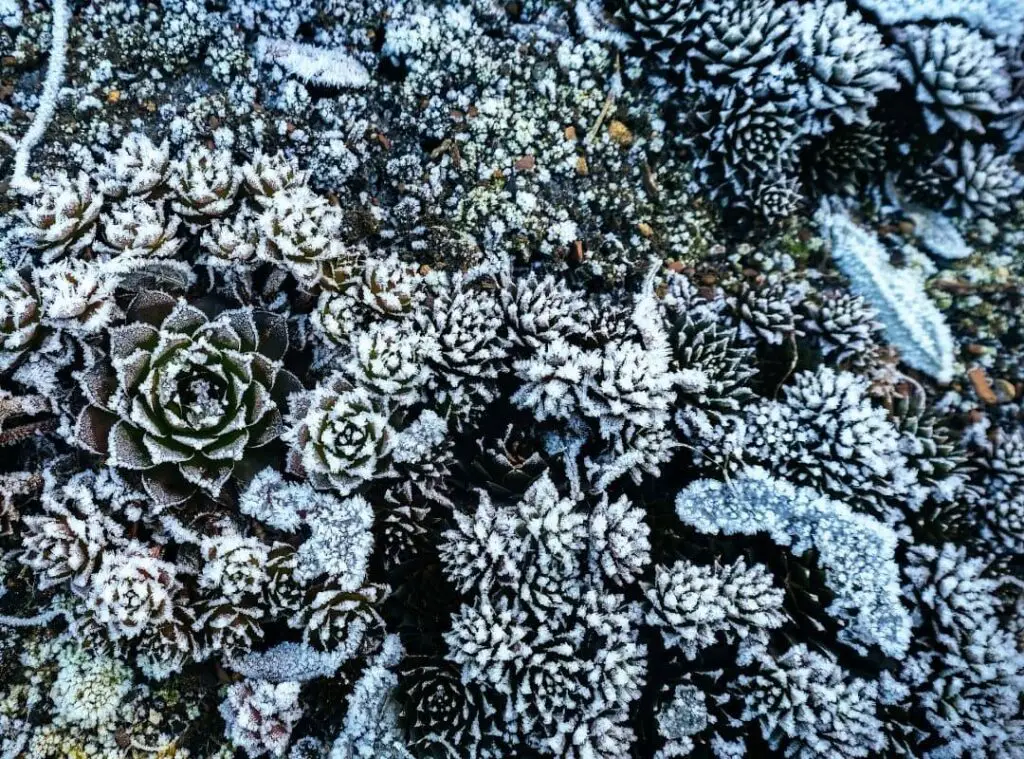
Moisture and Extreme Temperatures = enemies to the succulents.
Extreme temperature and moisture are considered one of the troublesome environmental conditions.
You must avoid any hot and wet, cold and wet conditions to protect your succulents. It does not matter if you plant them in the ground or in containers as long there is dry soil.
When the weather is exceptionally hot, water consisting of the soil starts to steam, baking the root system.
It is wise to water your succulents before 7.00 A.M in extreme climates in order to prevent any damages.
Subsequently, succulent plants prefer average temperatures as extreme weather affects them.
While cold temperatures cause frost damage, hot temperatures result in atrophy and burned patches. With the proper attention and care, you can avoid these destructive circumstances.
What temperature is too cold for succulents?
The healthiest temperature range always depends on whether the plant is a soft succulent or a hard one. When the temperature is over 32°F it is ideal for the soft succulents.
When the weather is under freezing temperatures it is too cold for the succulents to survive as their fleshy and pulpy leaves and stems start to freeze due to the cold.
Nonetheless, frost hardy succulents can endure chilly climates with -20° F. Zone 4-5 is regarded as the ideal zone for these succulents.
Even though frost hardy succulents can survive the low temperatures you must keep in mind that they need dry soil in order to prevent any rotting.
In the winter season, you must take good care of your succulents as the weather usually gets wet and snowy.
How does the cold affect succulents?
The survival of the succulent plants always depends on the type of the succulent.
In cold weather, cold-hardy succulents tend to thrive healthily without a change and they showcase an impressive change in colours.
However, the situation does not affect the same with the soft succulents.
In cold weather, they become dormant and freeze which causes the destruction of the plant eventually if you do not bring them indoors.
However, it is crucial to mention that everything in cold temperatures does not become terrible for succulents.
For instance, it never lowers below freezing in the winter season of southern California, still, it affects succulents to become dormant to have vibrant colours.
When the mixture of dry and stressed soil with a temperature that varies between 40-60°F for a long time causes a gorgeous effect on succulents.
Sometimes the pink, red or purple colours that the green succulents usually get a darker purple hue In the cold weather.
The stress and colours are not harmful to the succulents but it is important to pay attention to this.
Make sure to check the weekly weather forecast to find out if there are any weather drops below freezing in the week.
Then act accordingly moving your succulents indoors or covering them to protect the plants while preserving the cold weather colour.
It is not true if someone says outdoor gardens are successful in areas with warm weather. It is true that succulents grow gorgeous outdoors in sunny warm areas while it is difficult to garden succulents in the areas where there are four seasons per year.
Succulents varieties like Sempervivums and Stonecrop Sedums can tolerate temperatures below 20°F.
If you garden with cold Hardy succulents you will be able to have an elegant outdoor succulent garden no matter if it is winter or the summer.
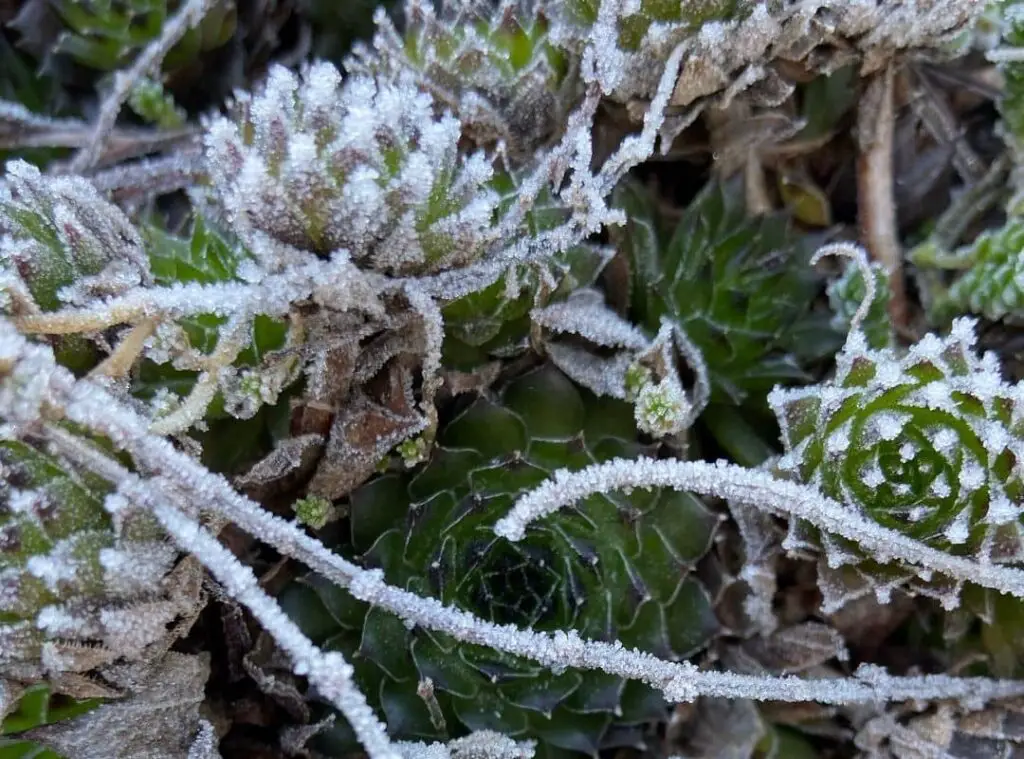
How cold hardy are succulents?
Many people love and prefer to garden cold-hardy succulents as they are truly appreciative as they require low maintenance among other succulent varieties.
You can simply plant cold-hardy succulents in the outdoors without worrying about how cold the weather may get.
This variety can tolerate growing temperature, freezing and below. Cold hardy succulents require less water to store water like soft succulents.
In general, cold-tolerant succulents thrive under extreme cold weather with -29°C temperatures.
Queen Victoria Agave, Sempervivum, Agave parryi, Sedum spathulifolium are distinguished as the popular cold-hardy succulents that can tolerate chilly weather.
Cold loving succulents
The succulent season does not come to an end with the summer. As you know there are gorgeous succulent varieties that thrive well in cold seasons.
Cold loving succulents are capable of taking below-zero temperatures as long as they receive full sun with dry soil.
Following are prominent cold-loving succulents that you can grow without worrying about the cold weather and snow.
Sempervivums
Sempervivums are considered cold-hardy succulent that can survive at 30°F temperature. Cold weather intensified its rosette tone into a darker or deep red colour.
These succulent species are naturally created to defend against the cold weather.
Sempervivum Red Lion
Sempervivum Red Lion is known as an everlasting succulent which is easy to maintain. This variety is perfect to plant in containers. You can plant these succulents outdoors in cold weather as they can survive in chilly weather.
Hardiness Zone: 4a – Zone 6a (-30°F to -5°F).
Sempervivum Mahogany
Sempervivum Mahogany is an evergreen, cold hardy succulent variety that lasts for a long time with its gorgeous multi-coloured rosettes. In the summer these succulents flourish with light pink, starry flowers from the leafy stems.
Hardiness Zone: Zone 3b – Zone 1 (-35°F to 40°F)
Sempervivum calcareum
This variety of succulents last for several years and they grow tall by about 6 inches. Sempervivum calcareum thrives as dense mats as they grow fast via short-stalked offsets.
Hardiness Zone: Zone 7b (5 to 10 °F)
Sempervivum Cobweb (Cobweb Hens and Chicks)
Sempervivum Cobweb is a small-growing variety of Sempervivum Tectorum. Similar to a cobweb the sharp blue-green rosettes are coated with criss crossing white lines.
Hardiness Zone: Zone 5a – 8b (-20 to 20 °F)
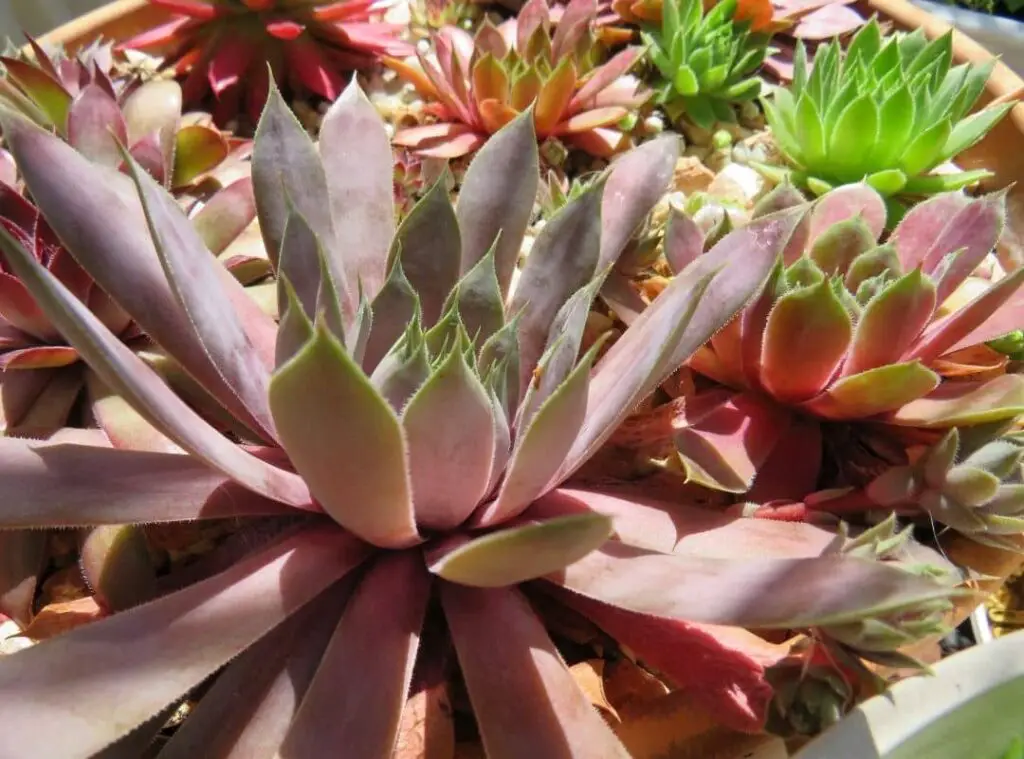
Hardy Sedum
Hardy Sedum, also known as Stonecrop Sedum is considered another resilient succulent variety.
Under cold weather, Hardy Sedum exhibits an interim death by dropping their leaves while new plants are forming under their dead leaves.
Most of the Sedum plants take vivid colours in cold weather and appear glorious regardless of the snow.
Sedum Dasyphyllum Major
In many countries, this succulent species is known by different names such as Corsican Stonecrop, Blue Tears Sedum.
These succulents are evergreen and they grow fast. Sedum Dasyphyllum Major plants are capable of enduring light foot traffic, preparing the plant to substitute low-water lawn.
Hardiness zone: Zone 5a – 6a (-20 to -5 °F)
Sedum Golden Moss
Sedum Golden Moss is an evergreen succulent variety which is ideal for plants in rocky gardens. In the spring and summer seasons, these plants create a glamorous cover with tiny star-shaped vivid yellow flowers.
Hardiness zone: Zone 3a – zone 9a (-40 to 25 °F)
Dragon’s blood sedum
Dragon Blood Sedum is a fabulous succulent that blossoms hot pink flowers usually in early to late summer. These succulents have leaves that get a greenish colour in warmer weather and turn into an impressive wine red when the temperature gets cooler.
Hardiness zone: 3a – 4a (-40 to -25 °F)
Sedum Spathulifolium (Cape Blanco)
Sedum Spathulifolium is known to be a charming miniature sedum with tiny white silvery rosettes. Rosettes of these plants get a plummy pinkish tone in chilly temperatures. Moreover, their rosettes are coated in a waxy covering resisting moisture loss.
Hardiness zone: 5a to 9b (−20 °F to 30 °F)
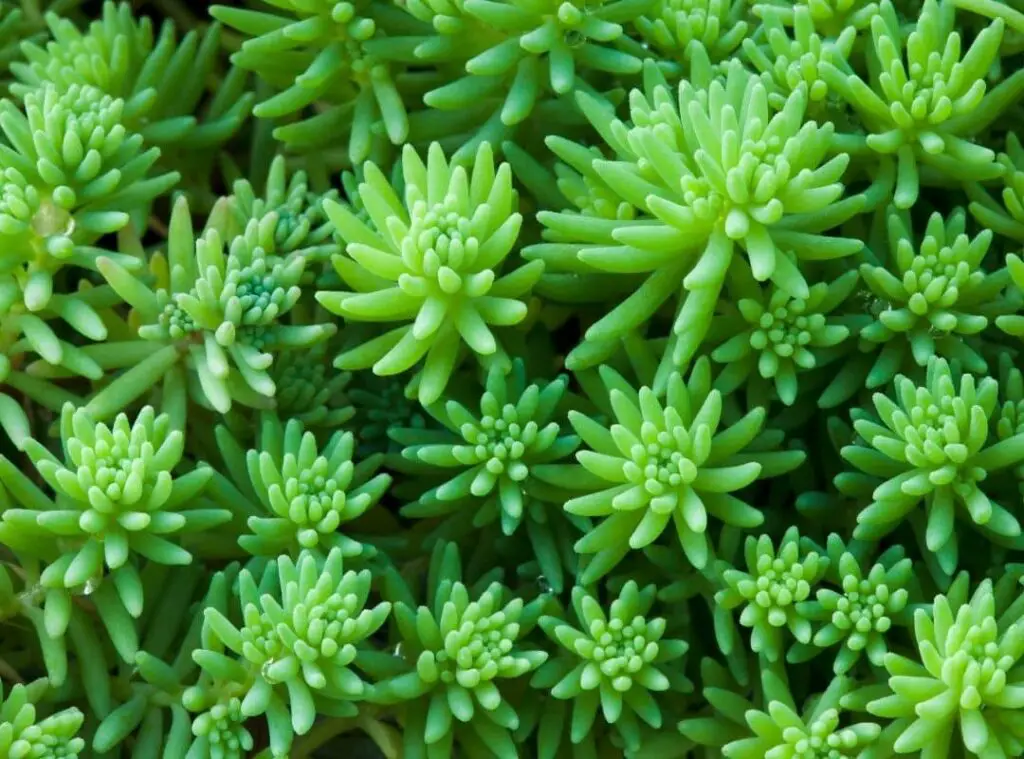
Ice Plant Oscularia Deltoides
Oscularia Deltoides is a succulent species that originated in South Africa.
These plants are created with plumpy, green leaves and purple flowers which are similar to daisy flowers that blossom in the summer.
With well drained soil and adequate watering, these succulents are capable of the plant both indoors and outdoors.
Agave Butterfly
Agave Butterfly succulents are originated from the semiarid Mexican states of Puebla and Oaxaca. These succulents usually become 2 feats taller once they grow up.
Agave Butterfly is a lovely plant with its greyish great and cream toned thick leaves. In the spring and summer, they grow happily and in the cold weather, they go through a dormancy period.
However, these succulents can tolerate the drought weather as well as the light frost.
In frosty weather make sure the succulents have good drainage when the snow begins to melt in order to prevent them from getting rot.
However, when moving back the cold hardy succulents to the snowy weather after extremely warm weather, it is crucial to provide them with a gradual adaptation before uncovering them in the winter.
What is winter dormancy in succulents?
When the cold weather persists for a long period it triggers soft succulents to go dormant. Succulents pause their growth until the weather warms them up.
Succulents are one of the most adored plants that attract everyone with their gorgeous look all over the year.
However, there are some phases in succulent lives that pause their growth. In this Dormancy period, succulents require the necessary care.
This you must be attentive to their dormancy period and the active period to provide proper care.
The dormant period of succulent plants is divided into two seasons as Winter Dormant and Summer Dormant.
Winter dormant succulents tend to grow actively during the spring, summer and fall months. Subsequently, these succulents undergo a short dormancy term in the warmest days of summer.
Even though winter dormant succulents prefer the hot weather some of their other succulents despise the drastic heat and use their growth to keep up their lives.
In this season you can clearly note these succulents drastically slow down their growth when the temperature goes down below 40°F.
It is crucial to remember that they easily rot in the tormented period if you do not limit the amount of water they are provided with.
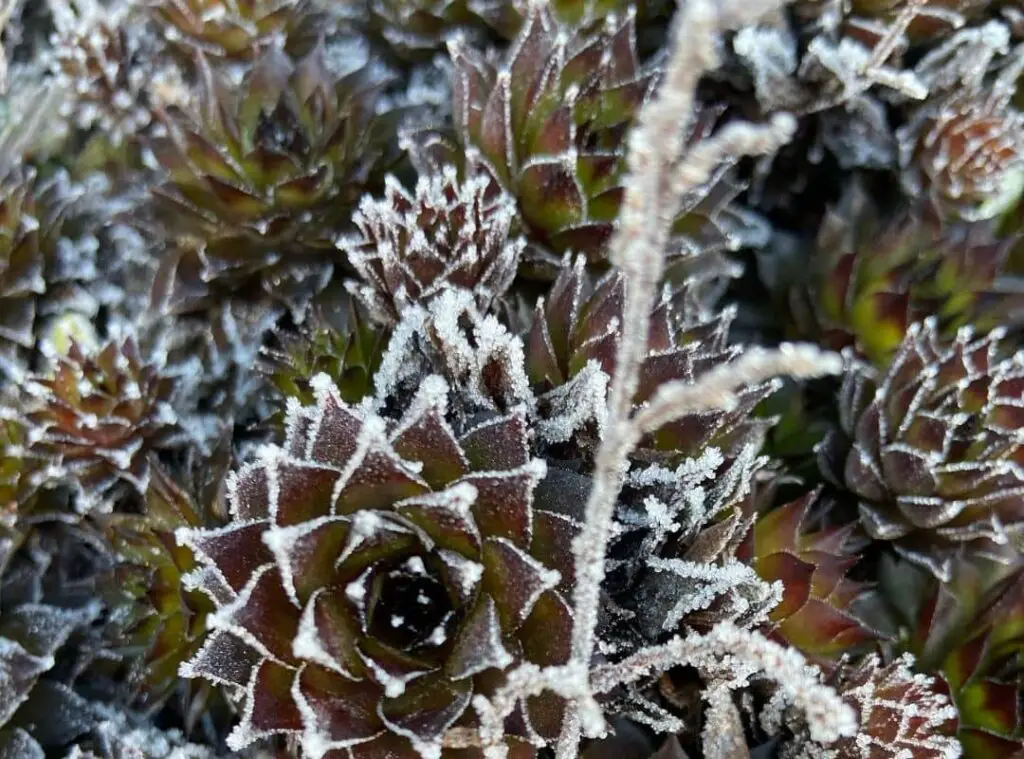
How to protect succulents from winter?
As succulents are known as drought loving plants that usually grow in arid climates, you must be wondering how to protect your succulents from the winter season.
If you follow the right methods, succulents can decorate outdoor gardens even in cold climates. However, winter can be quite damaging for specific types of succulents.
They will need to be safeguarded to assure they look wonderful as they were in springtime. So, how to take care of succulent plants in cold weather?
Moving the succulents indoors
In the winter season, it is important to move your soft succulent plants indoors to a porch, conservatory or greenhouse. If not, you can simply go for carpets, roof overhangs.
Accordingly, you will be able to keep your succulents safe in cold weather and snow. Garages that do not go beloved 50°F, are more appropriate to keep succulent safe in winter.
Even for the cold-hardy succulent, you must be vigilant about the climate if you have planted them outside.
If you do not have heating facilities in your greenhouse consider keeping your succulents on shelves or ledges to shelter them from the ground frost.
In addition to that, it would be beneficial if you could cover the succulents with horticultural material in situations where you cannot move the succulents in.
Maybe you have grown succulents that are appropriate to the hardiness zone in your area. However, it is always recommended to move them inside in the winter season.
Extreme temperatures can cause damage to succulents, yet you have to be careful when placing them indoors making sure that they get indirect sunlight for three to four hours and pest Problems.
Before taking succulent indoors, you must prepare them for that. Most of the time, plants that are kept outside are dirty compared to the plants placed indoors.
So try removing dead leaves and other rubbish from the container as they won’t untidy the indoors. Clean if there is any kind of excess dirt in the containers.
When moving plants, always remember to do it without creating a mess. Get rid from pests and dirt, then you are ready to go with the transferring of your succulents
Winter watering
Now you know that some cold hardy succulents go through a dormant period during the winter season.
So do not water those plants in the winter season in their dormant period as succulents require a less water amount.
Keep checking the moisture level of the soil. It is recommended to water succulent plants for about five minutes at a mild pressure when the soil is extremely dry and when they look as if they require water.
Another essential step is the usage of containers with enough drainage holes to prevent any kind of rotting.
If your succulents are placed indoors make sure the soil consists of sand and well-draining organic soil.
For cold hardy succulents planted outdoors, do not cover around them with mulch as it can trap water.
However, this might depend on the plant. Because every succulent does not go dormant in the winter season.
There are some succulent varieties that grow in winter. In this situation, you must identify the type of your succulents.
Therefore, they require more water compared to the other varieties. Pay more attention to the succulents kept near heaters and vents because they get dry easily.
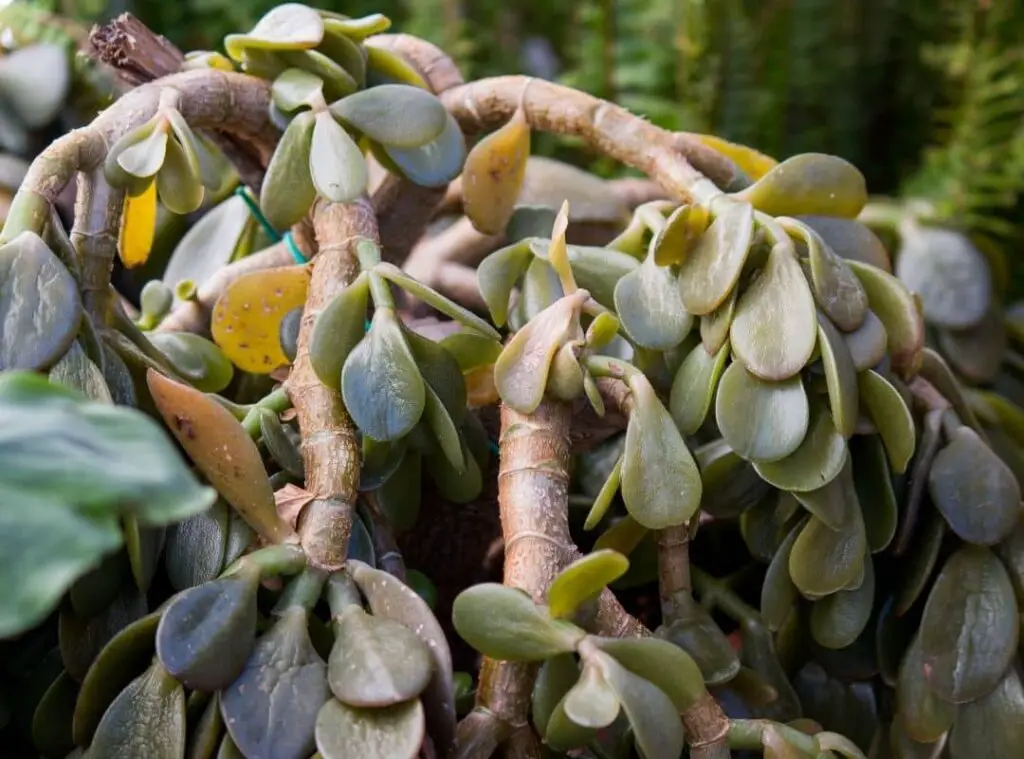
Soil condition
Do not plant succulents in glass containers with solid bottoms. Usually, the soil gets soggy in the winter season.
If there’s no light to dry out soil it will cause rot leaves while attracting pests. Use terra cotta and ceramic containers with enough holes to improve the drainage process.
In order to keep the soil from falling out, it is recommended to use mesh tapes of cheesecloths.
Succulents flourish gorgeously when they are planted in well drainage pots, make sure to always provide them with the proper soil and containers.
Pot maintenance
When moving succulents indoors in winter you need to prepare the pot well. It is necessary to clean the pot removing all the dirt, pests, dead leaves and cobwebs affixed to the pot.
As debris can rot your loving succulents it is important to clean the surface well. On the other hand, clean pots and the surface help to prevent pests and infections.
A mini tool kit might come in handy with cleaning. After cleaning you can decorate the top layer of the soil with beautiful pebbles.
Providing enough sunlight
It is a well known fact that in order to grow plants healthy it requires adequate sunlight. So do succulent plants.
In each day succulents require at least six hours of bright and direct sunlight to retain their shape.
When taking care of succulents kept indoors, providing enough sunlight especially in winter is one of the most difficult things which require attention.
This won’t be a problem if you place them near a window that gets the sunlight satisfactorily.
In greyish cloudy winter, you must have noticed the succulents grow towards the window as if they are searching for the sun.
This shows that your succulents did not receive enough light. So what can you do to avoid any stretching in your succulents? You can provide a grow light!!
However, as well as the light, succulents need to be kept in darkness for hours to accomplish their regular growth process.
If your succulent is out of shape due to the stretching while the plants were in search of sunlight you can propagate the plant by cutting off the upper part.
As most of the succulents pause their growth in winter do the removal in the spring.
Bug and pest inspection
Make sure not to welcome the troublesome pests when moving your succulents indoors.
Mealybugs are the most common succulent pest and investigate as you do not get any of them inside your house.
Moreover, there can be tiny bugs around the succulent. Remove all the pests and spiders from your succulents as they love to seek shelter in these pots.
You can find mealies, in the middle of the rosette, crevices and the axils of the leaf. You can catch Aphids and thrips usually in flower buds.
It is important to get rid of these little trouble makers as much as possible to keep your succulents healthier indoors.
Many people tend to use alcohol to eradicate pests that harm succulents. If you find an affected plant, separate it from the other plants and do as necessary.
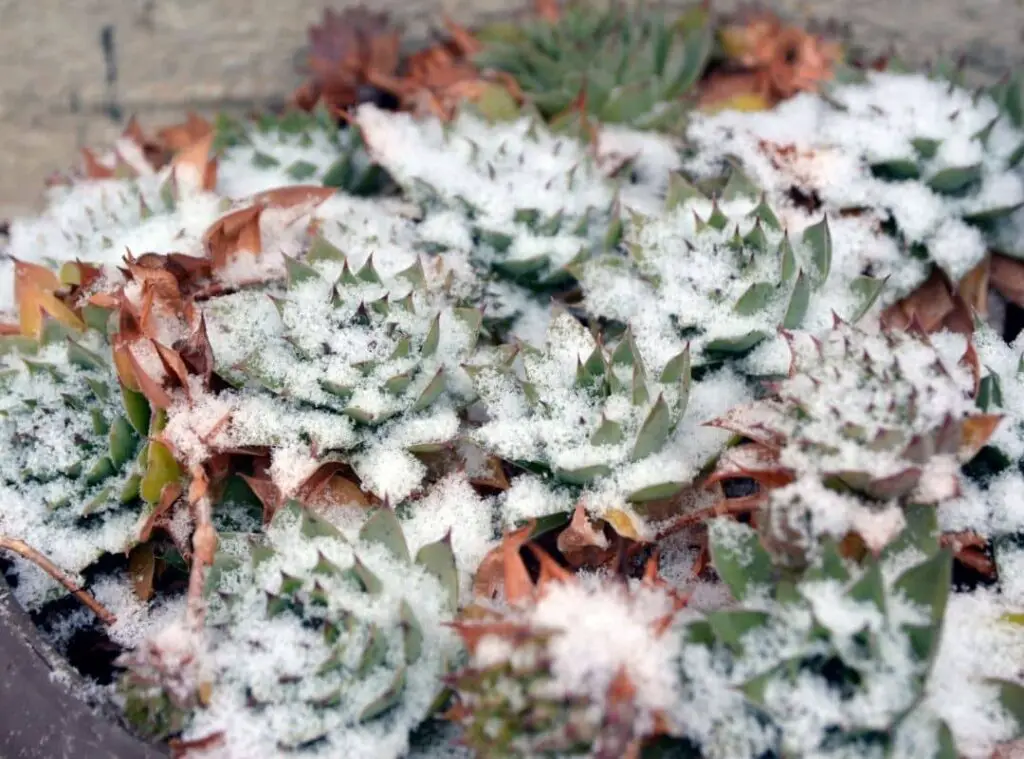
How does Frostbite affect the health of succulent plants?
Frostbites do severe damage to succulents while distressing the elegance of the plant. Frostbites mainly happen on fragile succulent plants rather than cold hardy succulents.
If you leave your tender succulents outside too long in the winter season, they might get affected by frostbites.
It is really disappointing to see your succulent buddy affected by frostbites. However, the plant can survive according to the harshness of the frostbite.
If you live in an area where the weather always goes below freezing in the winter, you should take your succulent plants inside your house.
If that is not possible, you can grow cold hardy succulents as they can survive the winter without getting frostbites.
So if your succulent plant has already got frostbites, what can you do?
As the first step, you should not expose the plant to the cold anymore. Place the plant out of the cold And let it dry for about several days.
Depending on the severity of the frostbite you may extend or shorten the days. You must let all the pulpy areas of the frost dry out.
When succulents get frostbites they naturally work on their healing and protect themselves against future damages.
Do not water succulents when they suffer from frostbites as it might cause rotting and destruction. When the affected area is completely dried out, remove it if possible.
Most of the time, it is noticeable that in the beginning frostbites affect the outer edges of succulents but do not spread to the centre of the plant.
In situations where frostbites have prepared the stem of the succulent plant, it is sorry to say that you probably won’t be able to redeem it.
Still, if the plant has got frostbites in areas you can remove and clean there’s a huge chance for your succulents to survive.
However, after removing the affected area, make sure not to water the succulents until it passes 2-3 days. Let the wound heal leisurely.
After the wound gets completely dry you can water the succulent. When watering, use the soak and dry method to improve the root growth.
Remember, unlike in other situations, you can’t expect new plants from the removed area.
However, if you follow the steps accordingly, your succulent will be healthy and thrive healthily as it was before.
This may take some time but when gardening succulents your patience matters the most. This might take a few weeks or months but stay patient until your succulent flourish beautifully and happily because it is worth the waiting.
If you are planning to move the affected succulent when it is completely recovered make sure that the plant is protected from cold, extreme heat and sunlight.
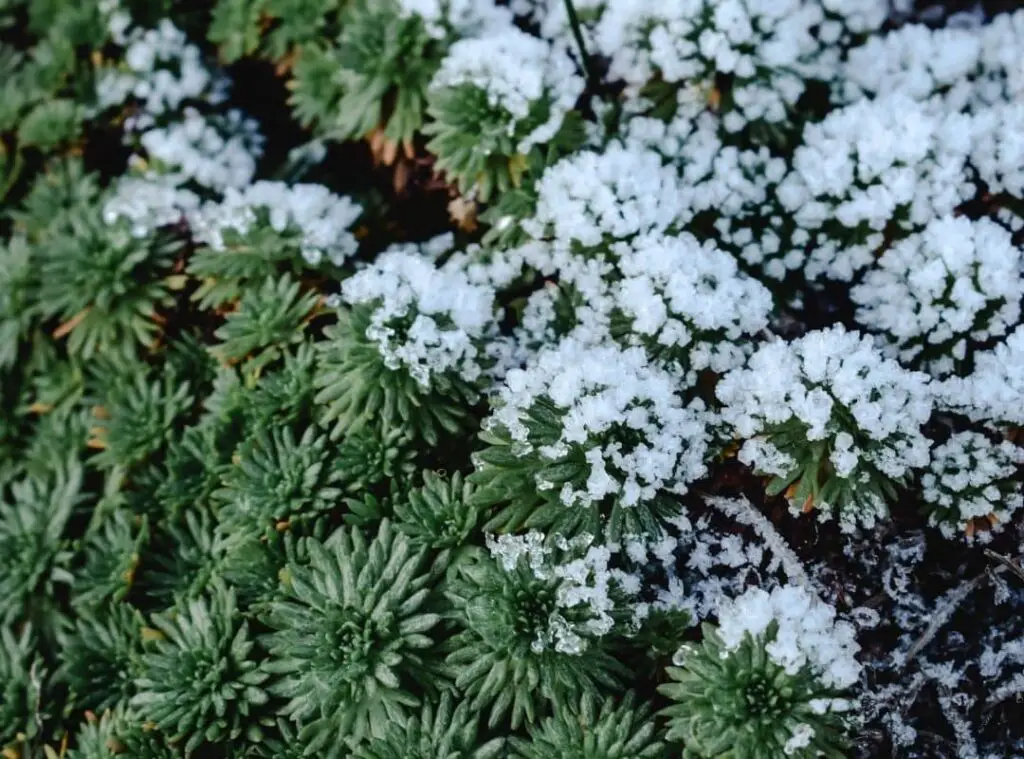
How to recover frozen succulent?
Your succulent can still survive even when the top part of the succulent is damaged while the root systems are not affected.
Freezing temperature causes huge cellular destruction both inside and outside of succulents. However, most of the succulent plants are incredibly hardy.
When succulent freezes, do not cut off the foliage or stems. You must stay patient for a period of weeks.
When it comes to plants like aloe and agave in order to check whether the core of the plant is damaged, pull softly on interior leaves.
If interior leaves can be easily pulled out with a mushy and black colour base, the plant is already dead and should be wiped out.
Further, If there are signs of new leaves and growth, it shows that the succulent is recoverable.
So if you find that your root system has not been affected you can keep hope to cure your succulent.
As the first step, take your succulent plant from the outside and place it indoors where it receives neutral temperature.
Subsequently, Remove affected leaves because that endangers the health of the succulent. If the soil consists of water, transfer your succulent to a new container that has dry soil.
Give the plant some time to get recovered. In the healing process do not water the plant or expose it to the cold temperature. Make sure your succulent receives enough sunlight.
Moving the succulent outdoor in the end of the winter
If you are waiting till the winter to end as you can start moving your succulents outside, you must move them back when the temperatures are free from dropping below 40°F.
When moving back, it is important not to uncover succulents to the harsh sunlight.
Begin by selecting a place in your garden where your succulent receives the morning sunlight as it is healthier than the drastic afternoon light.
As spring is the best season to flourish for the plants do not hesitate to move them outside. However, in the first 2-3 days keep your succulents outside for about five hours.
They need a little adaptation to the outside.
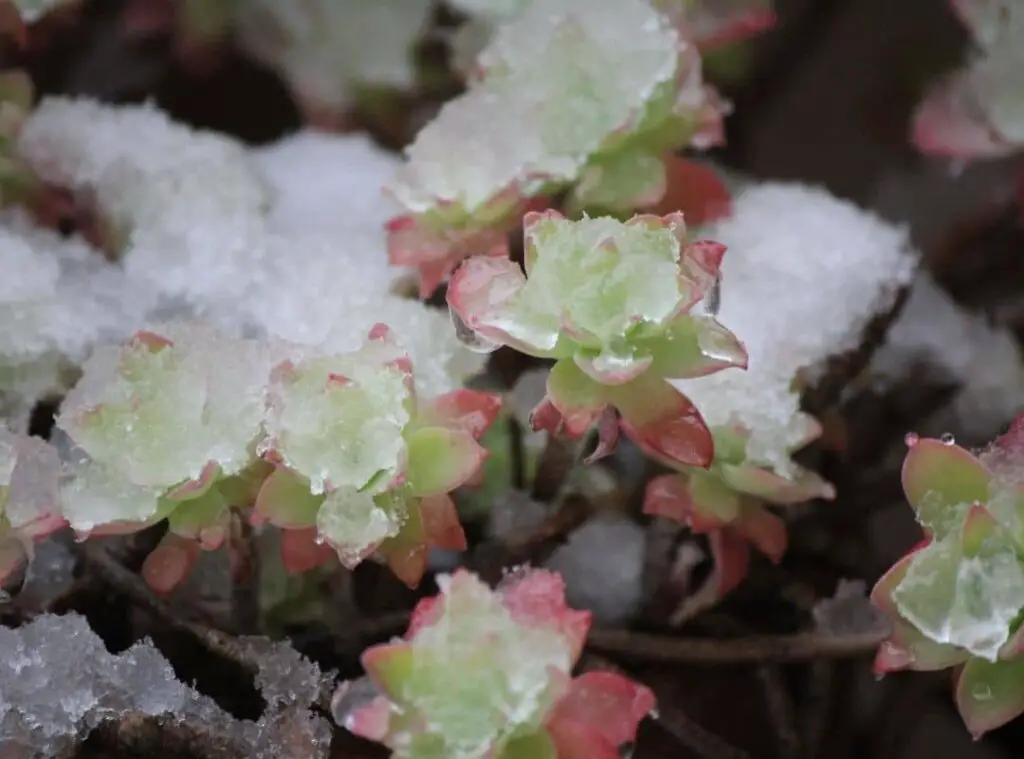
Related questions
How cold cactus can tolerate?
First, you have to identify the unhealthy temperature level for cactus plants. The healthiest temperature level is always dependent on the variety of the succulent.
Most of the cactus can not tolerate temperatures below freezing. However, there are cactus varieties that grow well in temperatures below 0°F.
Green flowered hedgehog can survive at a temperature level -20°F. Most of the cold hardy cactus can survive in freezing weather and expel water during the night time in order to not freeze.
Cactus plants have their own ways of surviving the chilly weather without freezing. In the winter season, keep your cactus plants above freezing.
Some varieties prefer when the night time temperature exists between 35°F-40°F. On the other hand, some cacti can tolerate below freezing if the soil is completely dry.
When to bring succulents inside?
There are two types of succulents such as the plants that can survive in the cold temperature (Cold hardy succulents) and succulents that can tolerate the cold temperature.
So moving the succulents always should be decided on the type of the succulent and the weather in the area that you are living in.
However, it is advisable to move succulents indoors when the temperature reaches extreme levels.
No matter where you keep your succulents, they need your attention and care in order to flourish beautifully and healthily.
Can succulents stay outside in winter?
Cold hardy succulents are capable of tolerating the cold weather in winter. If you live in an area where you go through all 4 seasons, cold succulents are the ideal variety for you.
As succulents store water in their leaves, they gradually begin to freeze and die in cold weather. Sedums, Sempervivums and Opuntia are known as the great selections to grow outside in winter.
They will thrive throughout the gear even when the climate gets below freezing. But you must make sure to keep the soil dry as frost becomes water once they begin to melt.
Read More : Elephant Bush Succulent | Why Is Everyone Talking About Them |
